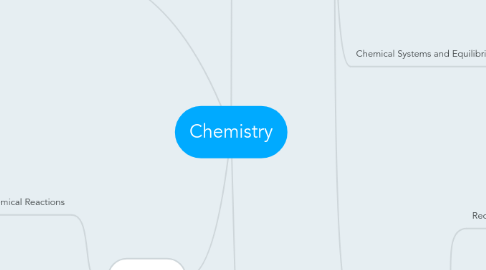
1. Grade 9
1.1. Bohr-Rutherford Atomic Model
1.1.1. Nucleus
1.1.1.1. Containing proton and neutron
1.1.1.2. Electrons orbiting in energy levels
1.2. Elements
1.2.1. Compounds
1.2.1.1. Ionic
1.2.1.2. Covalent (Molecules)
1.3. Physical vs. Chemical Properties
1.4. Periodic Table
1.4.1. Element Symbols and Names
1.4.2. Simple Compound Formulas and Names
2. Grade 10
2.1. Chemical Reactions
2.1.1. Compounds
2.1.2. Products
2.1.3. Reactants
2.1.4. Types
2.1.4.1. Synthesis
2.1.4.2. Decomposition
2.1.4.3. Single Displacement
2.1.4.4. Double Displacement
2.1.5. Word Equations
2.1.6. Balanced Chemical Equations
2.1.6.1. Law of Conservation of Mass
2.2. Simple Molecular Models
2.3. Chemical Changes
2.3.1. Evidence of
2.4. Physical Changes
2.5. Acids & Bases
2.5.1. Neutralization
2.5.2. pH Scale
3. Grade 11
3.1. Matter, Chemical Trends, and Chemical Bonding
3.1.1. Periodic Trends
3.1.2. Isotopes vs. Radioisotopes
3.1.3. Formation of Ionic vs. Covalent Bonds
3.1.3.1. Lewis Structures
3.1.3.2. Molecular Models with single & multiple bonds
3.1.4. Physical Properties of Ionic vs. Molecular Compounds
3.1.5. Activity Series of Elements
3.1.6. Polyatomic Compounds
3.1.7. Multivalent Compounds
3.2. Chemical Reactions
3.2.1. Types
3.2.1.1. Synthesis
3.2.1.2. Decomp
3.2.1.3. Single Displacement
3.2.1.4. Double Displacement
3.2.1.5. Combustion
3.2.1.5.1. Incomplete
3.2.1.5.2. Complete
3.2.1.6. Neutralization
3.2.2. Balanced Chemical Equations for all Types
3.3. Quantities in Chemical Reactions
3.3.1. Moles
3.3.1.1. Avogadro's Number
3.3.1.2. Molar Mass
3.3.2. Stoichiometry
3.3.2.1. Percentage Yield
3.3.2.2. Limiting Reagent
3.3.2.3. Percentage Composition
3.3.2.4. Empirical vs. Molecular Formula
3.4. Solutions & Solubility
3.4.1. Concentration
3.4.1.1. Stoichiometry
3.4.1.2. Dilution
3.4.2. Precipitates
3.4.3. Ionization
3.4.3.1. Dissociation
3.4.3.2. Net Ionic Equations
3.4.4. Solution
3.4.4.1. Solute
3.4.4.2. Solvent
3.4.4.3. Dilute/Concentrated
3.4.5. Properties of Water
3.4.5.1. Polarity
3.4.5.2. Hydrogen Bonding
3.4.5.3. Universal Solvent
3.4.6. Polar vs. Non-Polar
3.4.7. Solubility Factors
3.4.7.1. Temperature
3.4.7.2. Pressure
3.4.8. Arrhenius Theory of Acids and Bases
3.4.9. Strong vs. Weak Acids/Bases
3.5. Gases & Atmospheric Chemistry
3.5.1. Earth's Atmosphere
3.5.2. States of Matter in terms of Forces
3.5.2.1. Kinetic Molecular Theory
3.5.3. Ideal Gases
3.5.3.1. PV = nRT
3.5.3.2. Dalton's Law
3.5.3.3. Boyle's Law
3.5.3.4. Charles' Law
3.5.3.5. Gay-Lussac's Law
3.5.3.6. Combined Gas Law
3.5.4. Avogadro's Hypothesis
3.5.5. Stoichiometry
4. Grade 12
4.1. Organic Chemistry
4.1.1. Classes of Org. Compounds
4.1.1.1. Hydrocarbons
4.1.1.2. Alcohols
4.1.1.3. Aldehydes
4.1.1.4. Ketones
4.1.1.5. Carboxylic Acids
4.1.1.6. Esters
4.1.1.7. Ethers
4.1.1.8. Amines
4.1.1.9. Amides
4.1.2. Organic Chemical Reactions
4.1.2.1. Substitution
4.1.2.2. Addition
4.1.2.3. Elimination
4.1.2.4. Oxidation
4.1.2.5. Esterification
4.1.2.6. Hydrolysis
4.1.3. Polymers
4.1.3.1. Addition Reaction
4.1.3.2. Condensation Reaction
4.1.4. Isomerism
4.1.5. IUPAC Nomenclature
4.2. Structure and Properties of Matter
4.2.1. Electron Configurations
4.2.1.1. s, p, d, f orbitals
4.2.1.2. Pauli Exclusion Principle
4.2.1.3. Hund's Rule
4.2.1.4. Aufbau Principle
4.2.2. Forces
4.2.2.1. Intramolecular
4.2.2.1.1. Ionic Bonding
4.2.2.1.2. Covalent Bonding
4.2.2.2. Intermolecular
4.2.2.2.1. Van der Waals Forces
4.2.2.2.2. Hydrogen Bonding
4.2.2.2.3. Metallic Bonding
4.2.2.3. Physical Properties dependent on type of forces present
4.2.3. Atomic and Molecular Theory
4.2.3.1. VSEPR
4.2.3.2. emission spectrum
4.2.3.3. photons
4.3. Energy Changes and Rates of Reaction
4.3.1. Enthalpy
4.3.1.1. Endothermic
4.3.1.2. Exothermic
4.3.1.3. Specific Heat Capacity
4.3.1.4. Q=mcdeltaT
4.3.2. Energy Changes
4.3.2.1. Physical Change
4.3.2.2. Chemical Reaction
4.3.2.3. Nuclear Reaction
4.3.2.4. Bonds Formed/Broken
4.3.2.5. Hess's Law
4.3.3. Rate of Chem Rxn
4.3.3.1. Factors Affecting Rate
4.3.3.2. Catalysts
4.3.4. Potential Energy Diagrams
4.3.4.1. Activation Energy
4.3.5. Reaction Mechanisms
4.3.5.1. Elementary Steps
4.3.5.2. Rate Determining Step
4.4. Chemical Systems and Equilibrium
4.4.1. Le Chatelier's Principle
4.4.2. Equilibrium Constants
4.4.3. Bronsted-Lowry Theory of Acids and Bases
4.4.3.1. Properties of Acids/Bases based on Dynamic Equilibrium
4.4.3.2. Acid-Base Titration
4.4.4. Buffers
4.5. Electrochemistry
4.5.1. Redox Reactions
4.5.1.1. Oxidation Number
4.5.1.2. Balanced Chemical Equations for Redox Reactions
4.5.1.3. Reducing Agent
4.5.1.4. Oxidizing Agent
4.5.1.5. Half-Reaction
4.5.2. Galvanic Cells
4.5.2.1. Voltage
4.5.2.2. Overall Cell Potential
4.5.2.3. Half Cells
4.5.3. Industrial Processes
4.5.4. Corrosion of Metals
